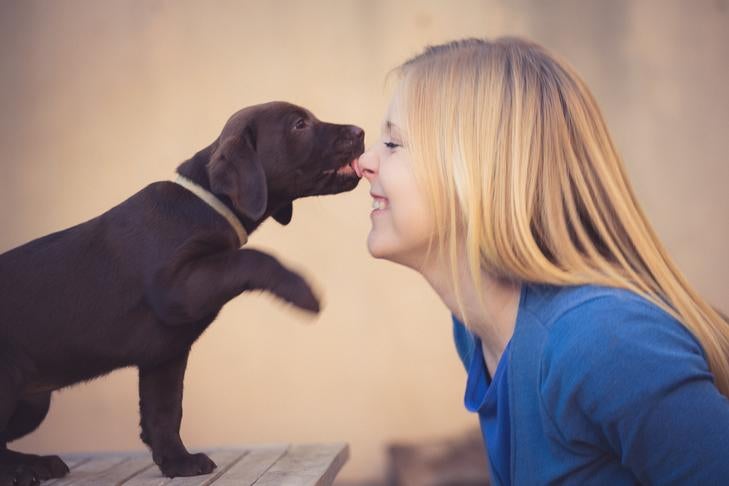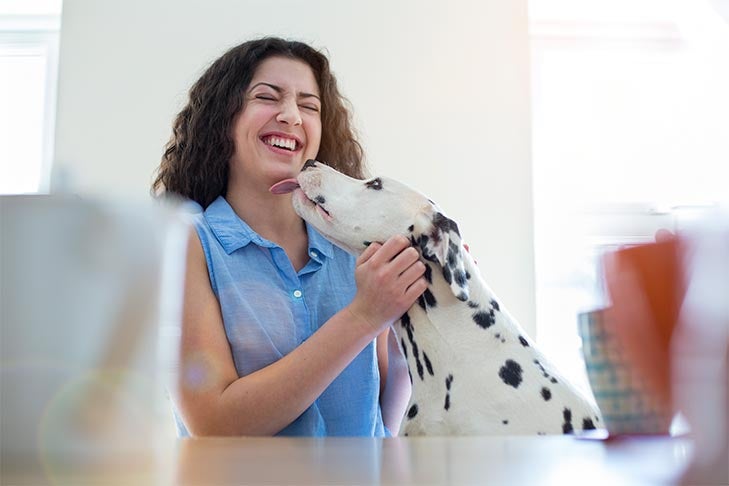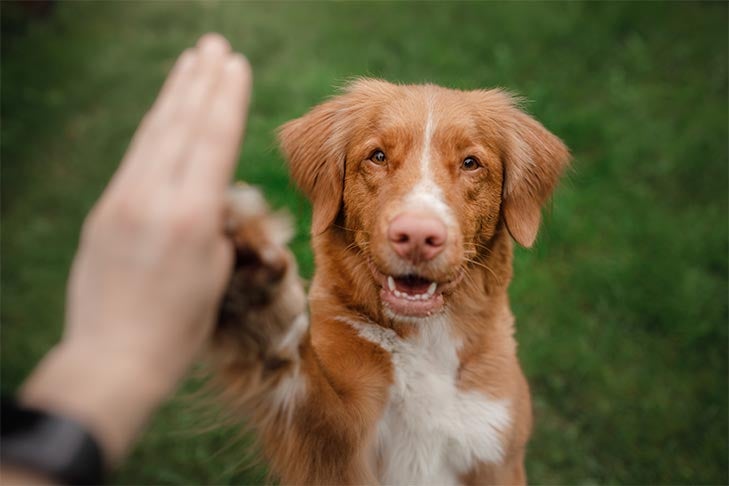
AKC is a participant in affiliate advertising programs designed to provide a means for sites to earn advertising fees by advertising and linking to akc.org. If you purchase a product through this article, we may receive a portion of the sale.
What’s better than coming home to a kiss from a happy dog? Most dog owners interpret the reason why dogs lick their owners as a sign of affection. But is this really why your dog is licking you? And what can you do if your dog’s licking behavior is out of control?
Is Licking a Dog’s Way of Kissing?
The jury is out on what a dog’s licking actually means. Believe it or not, what people interpret as affection might, in fact, be your dog encouraging you to throw up what you ate for lunch for them.
“Researchers of wild canids — wolves, coyotes, foxes, and other wild dogs — report that puppies lick the face and muzzle of their mother when she returns from a hunt to her den — in order to get her to regurgitate for them,” notes Dr. Alexandra Horowitz, head of the Horowitz Dog Cognition Lab at Barnard College, Columbia University.
Similarly, your dog could simply think that you taste nice. Certified applied animal behaviorist Dr. Mary Burch points out that humans have slightly salty skin, especially after sweating during exercise. Therefore, those licks might be more about seeking salt than giving affection. Horowitz adds that if your dog likes to lick your face, it will often happen after you’ve finished a delicious meal.

But, there is also evidence that licking is sometimes a sign of affection. Horowitz points out that, although it started as a food-seeking behavior, licking has now become a ritualized greeting for many dogs. Some wild species in the dog family will lick pack members just to welcome them home. So, those daily slobbers really might just be a sign that your dog is happy to see you.
“Licking can be a sign of affection,” explains Burch. “It might also give a dog a feeling of security and comfort, just as the dog had when licked by its mother in the litter.”
When Does a Dog’s Licking Become a Problem?
Most licking is harmless, even welcome as a form of self-expression on the dog’s part. Burch notes that there’s no need to worry that it’s a form of domination — in fact, it’s quite the opposite.
“One theory is the licking is a sign of submission,” she says. “The idea is that dogs who are submissive will lick a more dominant member of the pack.”
Even so, there are some scenarios when you might want to head off a slobber-fest from your pup. The first relates to human comfort, that is, some people simply don’t like being licked by a dog. If you have a friend who dislikes being licked by dogs, it’s kinder to dog and friend alike to redirect the behavior.
But sometimes licking is a symptom of a more serious problem. If your dog is licking themselves, you, or objects excessively, to the point that it seems like a self-stimulatory behavior, this might be a sign of anxiety, boredom, or pain. Obsessive self-licking can also be a sign of allergies or other health problems.
What Can Dog Owners Do About Problem Licking?
If your dog is self-licking excessively, start by having your veterinarian check them out and address any medical problems or discomfort. Once you’ve ruled out medical explanations, you can turn to behavioral solutions.
“One idea is to redirect your dog,” says Burch. “When they lick, switch up the activity. A good option is to choose a behavior that is incompatible with licking, such as using an interactive puzzle to get a treat. You can also have the dog engage in other behaviors such as ball play or trick training.”
By repeating this redirect, you’ll gradually reinforce the lesson that you don’t want your dog to lick, without ever using negative reinforcement.
Lick mats are specifically designed to tap into a dog’s enjoyment of licking in a positive (and non-destructive or irritating) way. Smear some dog-safe peanut butter or plain yogurt on a lick mat—or even serve your dog their meals on a soothing lick mat—to help satisfy their urge to lick.

Trick training, in particular, is a good way to turn a repeated undesirable behavior into an opportunity for positive reinforcement. Start by simply having the dog sit, which might stop the licking on its own, then reward the behavior with a treat.
Next, why not harness your dog’s affection by teaching them to give you a hug? Or to speak on cue? Other tricks to practice could include sitting up, army crawling, or leg weaving. If you and your dog find you really enjoy trick training, you could even look into AKC Trick Dog trials. If your dog’s excessive licking behavior was caused by boredom, getting involved in practicing for Tricks titles will do the, well, trick!
Whether or not you dive into trick training, always make sure that your affectionate, lick-happy dog gets plenty of attention and exercise. Excess energy can lead to over-licking or other, more destructive behaviors.
Need some help training your dog? While you may not be able to attend in-person training classes during COVID-19, we are here to help you virtually through AKC GoodDog! Helpline. This live telephone service connects you with a professional trainer who will offer unlimited, individualized advice on everything from behavioral issues to CGC prep to getting started in dog sports.

